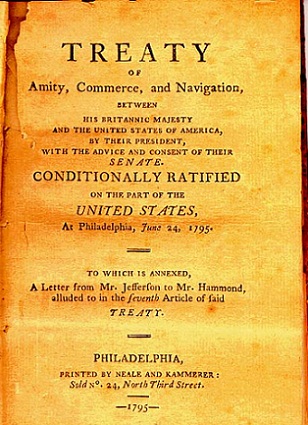Though over ten years had passed since the end of the American Revolution, the United States and Great Britain continued to quarrel. Some of the major issues were British retention of military posts in northwestern U.S. territory and her interference with American trade and shipping.
“Twenty years peace [will enable us] to bid defiance to any power on earth. Why then should we prematurely embarrass [ourselves?].” President George Washington

Library of Congress
President George Washington had much on his mind in 1794. War raged on the European continent, and despite issuing an official proclamation of neutrality, Washington nevertheless realized his country could not ignore completely the tumult in Europe between France and Great Britain. And though America had been independent for over a decade, relations with the former mother country remained tense. Britain refused to withdraw its troops from America’s western forts, denied American ships access to ports, and continuously interfered with what Americans regarded as their neutral shipping rights. Many regarded Britain’s provocative behavior as a stinging reminder that the English regarded the American Revolution as far from settled. But what options did the young United States and its first President have?
Taking up arms could prove foolhardy, since neither the American Army nor its Navy was a match for the battle-tested British military. And war with Britain could prove economically disastrous, dooming the still-vulnerable nation in its infancy.
But inaction carried its own risks. A failure to act might strengthen Britain’s resolve to continue its behavior. Washington’s political adversaries might accuse the President and his Federalist Party of a weak foreign policy.
There was a middle course. Recognized as a sovereign nation after its victory in the War of Independence, America had won the right to make treaties among the other recognized powers of the earth. Might diplomacy offer the United States some redress without the risks of all-out war?
Ultimately, Washington chose the path of negotiation. Convinced that America would not be ready to confront Britain militarily for at least “twenty years,” Washington believed the wisest path was to buy time through peaceful mediation. Signed in 1794, Jay’s Treaty took its name from America’s chief negotiator in London, John Jay.
Almost immediately, Washington’s political opponents leveled harsh criticism at the terms of Jay’s Treaty, complaining that it favored the British. But the treaty did include an agreement to remove British troops from American soil, and established better, more regular commercial relations between the two countries.
Today, historians take a more generous view of Washington’s actions than did his contemporary critics. With hindsight, it is easier to see Washington’s actions as prudent and farsighted. By buying time through negotiated settlement, the President avoided the immediate danger of a costly and potentially disastrous war with Britain—though America’s diplomatic actions did help provoke Britain’s European rival France.
And just as Washington had forecast, the treaty did help bring about almost twenty years of peace with Britain. Two decades of harmony finally ended with the outbreak of war in 1812.
Last updated: May 24, 2016
